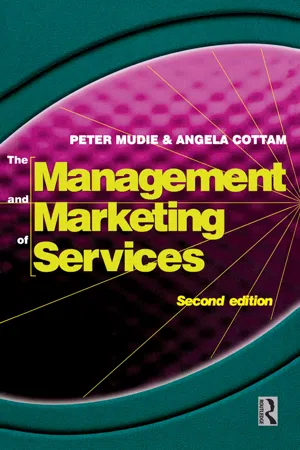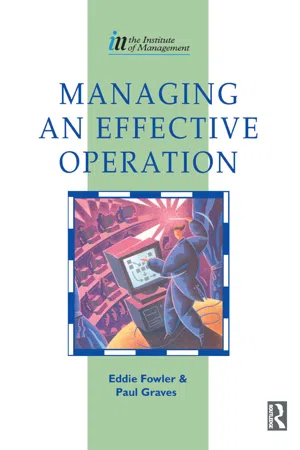Business
Measuring Quality
Measuring quality in business involves assessing the degree to which products, services, or processes meet established standards and customer expectations. This can be done through various methods such as customer feedback, performance metrics, and quality control processes. The goal is to continuously improve and maintain high standards of quality to enhance customer satisfaction and business performance.
Written by Perlego with AI-assistance
Related key terms
9 Key excerpts on "Measuring Quality"
- Connie Mok, Beverley Sparks, Jay Kadampully(Authors)
- 2013(Publication Date)
- Routledge(Publisher)
Interest in the measurement of service quality is thus understandably high, and measuring the quality of the service experience is now an integral part of most managers’ responsibilities. The challenge, however, is to identify and implement the most appropriate measurement tools for their operation. In stressing the importance of service quality to the hospitality sector, this chapter seeks to investigate the conceptualization and measurement of service quality and the relationships between service quality, customer satisfaction, and customer retention. In so doing, it shall identify and critically examine a number of the more popular techniques commonly employed within the hospitality industry.DEFINING QUALITY IN THE CONTEXT OF SERVICE
Numerous attempts have been made to define service quality and the closely related concept of customer satisfaction (Oliver, 1980; Tse and Wilton, 1988). Unlike product quality, which in itself is particularly hard to define, the search for a working definition of service quality is further complicated by the highly transitory and intangible nature of most services. At its most basic, quality has been defined as “conforming to requirements” (Crosby, 1984). This implies that organizations must establish requirements and specifications. Once established, the quality goal of the various functions of an organization is to comply strictly with these specifications. However, the questions remain, whose requirements and whose specifications (Palmer, O'Neill, and Beggs, 1998)? Thus a second series of definitions state that quality is all about fitness for use, a definition based primarily on satisfying customers’ needs (Juran, 1982). These two definitions can be united in the concept of customer-perceived quality, where quality can be defined only by customers and occurs where an organization supplies goods or services to a specification that satisfies their needs.There have been numerous attempts to encapsulate the essential nature of the service quality construct in the form of theoretical models. One of the earliest models is that described by Gronroos (1983), which relates the level of experienced quality to both technical and functional dimensions of service provision (see Figure 10.1- eBook - ePub
- Peter Mudie, Angela Cottam(Authors)
- 2010(Publication Date)
- Routledge(Publisher)
Chapter 5 Service Quality Introduction It is widely acknowledged that efforts to define and measure the quality of products have proved more successful than the definition and measurement of service quality. The characteristics of services have made the determination of what constitutes quality more difficult and hence its measurement less than comprehensive. To increase our understanding and to enable practical steps to be taken, two things need to be attained: Specification of the determinants of service quality Measurable quality standards. Achievement in these two areas will vary depending on whether the focus is: A low-contact or a high-contact service, e.g. fast-food outlet versus an education course Process or output. Determining the process and output quality of a fast-food restaurant is arguably more straightforward than an education course. Whatever the service, it is useful to bear in mind the following questions when it comes to quality: What is the service supposed to do? What does the service actually do? Quality then refers to the extent to which a service is what it claims to be and does what it claims to do. It must not be confused with grade. For example, the quality of a library cannot be judged in an abstract way by, say, counting the number of Shakespeare volumes possessed and subtracting the number of light romances. Instead the prime aspect of quality is whether the library provides people with what they want – it is a good library if it does and a bad library if it does not. 1 One eminent spokesman in the quality business over many years is Philip Crosby. In an update 2 of his most famous book Quality is Free he berates the army of bandwagoneers for having made a good living out of quality by reducing a profound idea to a set of box-ticking exercises such as ISO 9000 or the criteria for entry for quality awards. These, he claims, just encourage the notion that quality is about techniques and systems - eBook - ePub
- Frank Rowbotham, Masoud Azhashemi, Les Galloway(Authors)
- 2012(Publication Date)
- Routledge(Publisher)
Quality is complex and multi-faceted. Three classes of quality are identified:1 Design – the extent to which the product/service design meets customer needs – fitness for purpose.2 Conformance – the extent to which the process delivers a product/service which meets the design specification – conformance to specification.3 Operational – the extent to which the process produces conforming output without inspection/rejection – ‘right first time’.All three must be correct to produce excellent output. CostThe costs of prevention, appraisal, internal failure and external failure have been identified. These may be classed into costs of conformance and costs of failure. There will be some ideal point at which these two costs are in balance, representing the optimum level of quality. In practice this might not be identifiable and is always changing under the influence of competitive pressure.MeasurementMeasurement of design quality depends upon the measurement of customer needs and perceptions and is more an activity of marketing than of operations. Measurement of conformance and process quality is frequently carried out using samples and the techniques of statistical quality control. These methods always imply that some defects are acceptable. When this is not the case, 100 per cent inspection or even ‘burning-in’ may be used.Service quality poses particular problems since it cannot be inspected prior to delivery. Again, the methods used are usually those of market research. Control and improvementControl alone is rarely seen as an adequate response to quality issues. The total quality movement has led to an almost universal stress on continuous improvement. TQM implies a total commitment of the whole organization to continuous improvement of quality. The ultimate stage is described as an organization totally committed to maximizing customer satisfaction. - eBook - ePub
- Eddie Fowler, Paul Graves(Authors)
- 2013(Publication Date)
- Routledge(Publisher)
At the heart of every organization’s drive for quality are the systems designed to deliver it. These systems are described together with an approach to ensure they are as good and useful as they can be. We explore the value and methods of involving in these systems your staff, suppliers and customers. How that involvement is arranged is important and we provide some advice.We describe setting targets and monitoring performance against those targets and indicate the value and methodology of sharing that information with everyone through open displays within the operating environment.We conclude with a brief look at the part new technology plays in quality and quality improvement. This chapter relates to the following MCI Management Standards.• M1/1.1: Maintain operations to meet quality standards.• M2/1.1: Identify opportunities for improvement in services products and systems.• M2/1.5: Introduce, develop and evaluate quality assurance systems.• M2/2.2: Establish and agree customer requirements.• M2/2.3: Maintain and improve operations against quality and functional specifications.What is ‘quality’?The Oxford dictionary says quality is ‘degree of excellence’. While this may be fine in a casual context, as a definition against which we can run our operation it lacks some depth and detail. What you consider to be a ‘quality’ item or performance may be greatly different to the views of others. When these differing views are held by you and the people your operation serves (your customers) trouble can result. Your output, of which you might be pleased and proud, may be unsatisfactory to your customers if their expectations are either higher, or just different.Box 4.1In a busy restaurant, the waiters are constantly on the move between tables and the kitchen. They welcome customers, seat them, take orders, they deliver meals, they clear the tables, and they handle payment. As the menu provides a wide and varied choice, customers often take quite a time deciding on courses and the minutes tick by, with waiters trying to encourage and advise on choice, without ever being seen to hustle or hurry customers. Overall, customers are rarely kept waiting between courses more than ten minutes and this is fine and acceptable to most groups on an evening out. A few customers, however, may be on a tighter schedule – for the theatre, for instance – and a ten minute wait is less acceptable to them. So the same operational performance can please some and annoy others. Both parties would see the quality standards as differing markedly. Yet it is the same service level. - eBook - ePub
Operational Performance Measurement
Increasing Total Productivity
- Wilfred Kaydos(Author)
- 2020(Publication Date)
- CRC Press(Publisher)
DETERMINING WHAT TO MEASUREDetermining what variables to measure and how to measure them is not an exact science, but there are some general principles and practical methods that can be used. An overview of the general approach for determining the quality variables a company should measure is shown by Figure 5–1 .The steps for determining the quality variables to measure in a company or other business unit are as follows.Figure 5–1Sequence for Determining What to Measure- Identify the customers of the process. For the company’s customers, there could be different groups of customers (market segments) who receive different products or have different quality requirements for the same or similar products.
- Identify the key deliverables supplied to the customers. This assumes that all customer requirements are being addressed.
- Determine the customers’ quality requirements for each product. These are the output, or Level 1, quality measures.
- Identify the processes providing each of the products.
- Determine how each principal business process works and identify the variables that affect the quality of its products. These are the Level 2, or process control, measures for the principal processes.
- Determine the appropriate measures for controlling sub-processes, to as many lower levels as necessary to provide sufficient detail for establishing accountability and to get as close as seems practical to the root cause of quality problems.
Determining What Customers Want“The business process starts with the customer In fact, if it is not started with the customer, it all too many times ends with the customer”William ScherkenbachWhether customers are external or internal, there is no better way to determine what they want than to ask them. This can be accomplished in real-time, as customers are using a product, or on a historical basis after they have used a product. - eBook - ePub
Customer Experience Management for Water Utilities
Marketing urban water supply
- Peter Prevos(Author)
- 2017(Publication Date)
- IWA Publishing(Publisher)
The ISO 24510:2007 standard on performance measurement for water utilities provides guidance on both the technical and functional aspects of water utility performance. This standard presents a customer-focused view of service quality and recommends practitioners to consider aspects such as billing frequency and accuracy, both the health and aesthetic quality of water, and standards for complaints management (International Organizational for Standardization, 2007). This standard provides a range of focus areas for service quality but does not prescribe on how these measures should be developed.Over the past three decades, marketing scholars have developed various models to measure service quality. Some of the most often cited models are the SERV QUAL and SERV PERF measurement scales, which are both based on psychometric measurement theory. Service quality is a construct of the mind that can only be measured by asking customers a series of questions that relate to their experience with the service or product. The SERV QUAL and SERV PERF scales have been mentioned in industry literature (Babakus, 1993; Vloerbergh et al., 2007), but no evidence has been found of these being implemented in practice.This chapter develops SERV AQUA which is a conceptual model to measure quality in water utilities based on the principles of Service-Dominant Logic (S-D Logic). The model consists of the hypothesised dimensions of technical and functional quality, as assessed from two perspectives: quality viewed intrinsically by the service provider and extrinsically by the customer. The first section defines the concept of quality overall and how it relates to S-D logic. This theoretical model is used to develop a service quality scale for water utilities. This chapter closes with examples on how to apply these theoretical concepts to water utility practice by combining physical measurements and customer observations into an indexed water system performance report.6.1 DEFINING QUALITYQuality can be easily understood from a common-sense perspective but it is a notoriously hard concept to define. Quality is an elusive construct for which a range of mutually exclusive definitions, each with its own variations, exists. Water utility professionals associate the word quality mostly with the objective physical quality of water. From a marketing perspective is a broader concept that also includes the subjective experiences of customers. These experiences can include using the tap water or interacting with employees. The quality of water consists of both the objective physical parameters of its pressure and purity, as well as the subjective psychological dimensions of the aesthetics of water. - eBook - ePub
- Jessica Keyes(Author)
- 2016(Publication Date)
- Auerbach Publications(Publisher)
Table 2.2 .The TQC approach places quality/productivity assessment high on the list of software-development tasks. When projects are first defined, along with understanding and evaluating the process to be automated, the team defines the metrics that are to be used to measure the process.HP has also established a systems software certification program to ensure measurable, consistent, high-quality software through defining metrics, setting goals, collecting and analyzing data, and certifying products for release.HP’s results are impressive. Defects are caught and corrected early, when costs to find and fix are lower. Less time is spent in the costly system test and integration phases, and on maintenance. This results in lower overall support costs and higher productivity. It has also increased quality for HP’s customers. HP’s success demonstrates what a corporate-wide commitment to productivity and quality measures can achieve.Balanced Scorecard
We addressed the concept of the IT roadmap in Chapter 1 . One of the popular techniques that many companies have selected is the balanced scorecard, as shown in Figure 2.1 . Heralded as one of the most significant management ideas of the past 75 years, the balanced scorecard has been implemented in companies to measure as well as manage the IT effort.Robert S. Kaplan and David P. Norton developed the balanced scorecard approach in the early 1990s to compensate for their perceived shortcomings of using only financial metrics to judge corporate performance. They recognized that in this “New Economy” it was also necessary to value intangible assets. Because of this, they urged companies to measure such esoteric factors as quality and customer satisfaction. By the mid-1990s, the balanced scorecard became the hallmark of a well-run company. Kaplan and Norton (2001) often compare their approach for managing a company with that of pilots viewing assorted instrument panels in an airplane cockpit—both have a need to monitor multiple aspects of their working environment. - Peter Szende, Alec N. Dalton, Michelle (Myongjee) Yoo, Peter Szende, Alec N. Dalton, Michelle (Myongjee) Yoo(Authors)
- 2021(Publication Date)
- Emerald Publishing Limited(Publisher)
Chapter 9
Measuring Quality
Michelle (Myongjee) Yoo and Alec N. DaltonAbstract
This chapter covers four main concepts: service quality, quality assurance for measurement, quality assurance for management, and service failure and recovery. The first section mainly discusses the fundamentals of service quality. The service quality gap model is also highlighted to identify the gaps between customer expectations and the actual perceptions of service at different stages of service delivery. In the second section, different measurement methods for quality assurance are demonstrated. Examples of qualitative and quantitative methods are included.In the third section, the important management objectives of quality assurance, improvement, and control are covered. By using a combination of the quality assurance methods from the second section, hospitality operators can accomplish internal accountability, external accountability, performance improvement, and innovation. In the fourth and final section, causes and consequences of service failures are covered together with the service recovery paradox to express the implications of poor quality.- eBook - ePub
Service Design
From Insight to Inspiration
- Andy Polaine, Lavrans Løvlie, Ben Reason(Authors)
- 2013(Publication Date)
- Rosenfeld Media(Publisher)
CHAPTER 8 Measuring Services Measurement for the Common Good Establishing a Truth with Management Apples and Oranges—Define Baseline Data before Design and Launch Making the Case for Return on Investment Using the Service Blueprint to Model Measurement Money Talks Avoiding Common Mistakes When Measuring Services Measurement Frameworks SERVQUAL and RATER The Triple Bottom Line SummaryService designers and service providers both have a need to prove that design provides a return on investment. Results can be measured in terms of money made or saved, in an improved customer or user experience, value created to society, or reduced drain on the environment.We have not found a single, perfect method of measurement that provides robust evidence for the value of service design. However, it is important to define some measurement criteria before a new design is launched and to track these parameters to prove value and improve the service. You will do yourself and the field of service design a great favor if you always include the definition of performance indicators in your proposals. Exactly what to measure is likely to vary with each new service design.In the industrial age, leaders like Henry Ford and General Motors’ Alfred Sloan developed science-based corporate measurement systems to enable them to “manage by the numbers.” It soon became apparent, however, that this approach lacked the systems approach needed to ensure quality and improve performance on a continual basis.1After World War II, W. Edwards Deming, an American statistician and management guru, pioneered a more systems-based approach that first proved its effectiveness in the Japanese automotive industry. In the 1990s this came to be known as “lean” enterprise or production—a focus on removing every tiny inefficiency from manufacturing processes. Many enterprises in the service sector use “lean” as an approach to improve their services, but this method flourished in the industrial tradition, and although it may make service delivery more efficient, it rarely improves the customer experience. Ironically, Deming himself argued that a myopic focus on efficiency and the elimination of product defects was not enough. Instead, companies should try to predict the underlying customer needs and think about what products or services will be required 5 to 10 years from the present and innovate for that future.2 Measuring efficiencies in production makes sense from an industrial point of view, although the sustainability agenda requires companies to consider the full life cycle of products. But for services, what must be measured is consumption —the experiences of the service provider’s agents and users.3
Learn about this page
Index pages curate the most relevant extracts from our library of academic textbooks. They’ve been created using an in-house natural language model (NLM), each adding context and meaning to key research topics.








